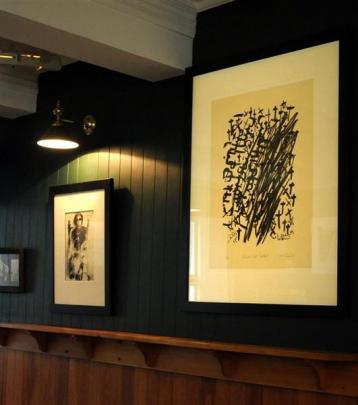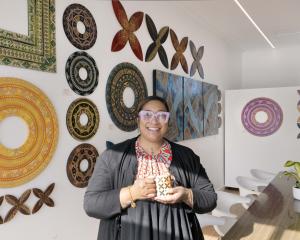One of New Zealand's finest private collections of Ralph Hotere works will be shipped out of Port Chalmers this weekend.
Nigel Benson makes a final visit to the Carey's Bay Hotel exhibition.
Last drinks will be called on an exhibition covering the life and times of artist Ralph Hotere this weekend.
The collection of 13 works was installed in the Carey's Bay Hotel during a $1m refurbishment by then owners National Business Review publisher Barry Colman and his late wife, Cushla Martini, between 2001 and 2005.
"As a collection, it's a good documentary of Ralph's life in Careys Bay," Hotere's godson, Dunedin artist Ben Webb, says.
"They're works that illustrate his life here in Careys Bay. Ralph even used to drink at the Carey's Bay pub."
The collection covers Hotere's work from 1973 to 1992, and includes the flagship Vive Aramoana, which Colman bought for a then-record price of $210,000 in June, 2002.
The works have remained on loan to the hotel since the business was sold to Brian, Mary and Jo Kidston last April.
"Vive Aramoana is one of his most definitive works of the period," Webb says.
"It directly references the proposed aluminium smelter at Aramoana, which he was an opponent of and actively campaigned against, with a lot of other people."
A 1989 lithograph references the destruction of Observation Point, where Hotere had his studio, during the 1993 development of Port Otago.
The Hotere Garden Oputae was built near the site by the port authority as part of the settlement arrived at on the issue, in 2005.
A pair of 1990 lithographs from his Aramoana Pathway to the Sea series look towards the sea from Observation Point.
"They were the views Ralph could see during the day and at night time looking down the harbour lights towards Aramoana," Webb says.
"A lot of these works are about personal things.There are also lyrical works which represent abstracted views from the studio."
A 1989 multimedia work shows a ship resting improbably on a horizon.
"It's like a working drawing for his most important sculpture, Black Phoenix, which was later bought by Te Papa," Webb says.
The inspiration for Black Phoenix came when the boat Poitrel was destroyed in a fire at Miller and Tunnage boat-builders in 1984.
Hotere turned the boat into a sculpture, which was installed in the Dunedin Public Art Gallery from February to April, 1985.
It was bought by Te Papa in 1989 and installed in the Wellington national gallery.
A 1991 work from the same series, Black Phoenix II, overlooks Port Chalmers from the Hotere Garden Oputae.
Coincidentally, a 1991 collaboration with Bill Culbert made of corrugated iron and neon light tube, which also protests the destruction of Observation Point, PROP, is on display at the Dunedin Public Art Gallery until February 14 next year.
Hotere would often wag an angry paintbrush at what he considered arrant foolishness.
Black Union Jack protested the 1981 Springbok tour, the Polaris series was a response to the nuclear Polaris missile in 1984, and Black Rainbow condemned the French bombing of the Greenpeace Rainbow Warrior in 1985.
Several of Hotere's friends are also represented in the collection.
There's a 1990 lithograph of a ceramic statue by his friend Russell Moses, a Port Chalmers sculptor, while another piece shows his stagework with Patric Carey at the Globe Theatre in the early 1970s.
Winter Soltice at Careys Bay shows the comforts of home, while A Window in Spain looks far across the seas.
"That references Ralph's trips around Europe in 1978.It's a lithograph form of his canvases that he did some years after he got back," Webb says.
As for Hotere himself: "There are few things I can say about my work that are better than saying nothing," he once said.
The 78-year-old has been reliant on a wheelchair since a serious stroke in 2002.
"After the stroke, everyone thought `Well, that's it, he'll never do anything again'," Dunedin art historian and curator Peter Entwisle said this week.
"But, he was able to continue.I think Ralph has to work to live ... [and] for his own internal wellbeing.
"He's our greatest living contemporary artist.I don't think there's much doubt about that. He's like Picasso. His works aren't like Picasso's, but as a creative personality he's like that.
"Frances Hodgkins was the first New Zealand artist to really break through international boundaries and Colin McCahon came a generation later. Ralph is the next in line."
Hotere's most recent public work was when he collaborated with Auckland pop artist Billy Apple on an installation at the Brett McDowell Gallery in October last year, when he used a blue brush to paint a post red.
"It's really quite amazing what he's done. He's the consummate artist," Entwisle says.
"He's a fantastic colourist, a brilliant draughtsman and an amazing innovator. He can do the beautiful and the angry and the pithy. Everything he touches turns to art."
Or, as Dunedin arts commentator David Eggleton once noted, "Everything he touches turns to black".
Carey's Bay Hotel publican Jo Kidston said she was sad to be losing the works.
"But, we are grateful to have had them as long as we have," she says.
"We're now going to turn the space into a gallery, where people can exhibit their art."
The works are destined for Mr Colman's new National Business Review offices in Auckland.
Last chance
Last chance to see the works at the Carey's Bay Hotel is today and tomorrow.













